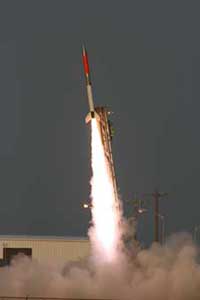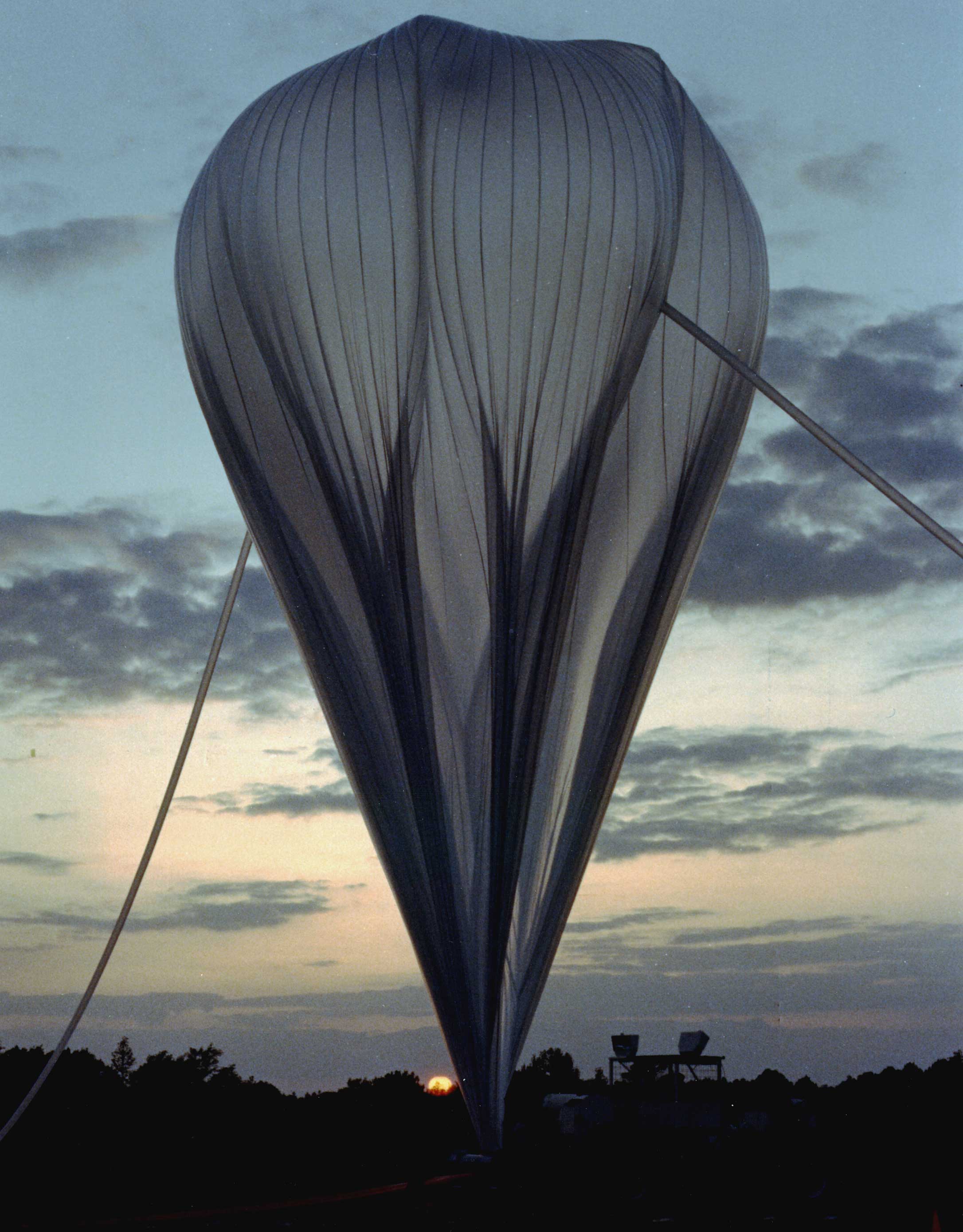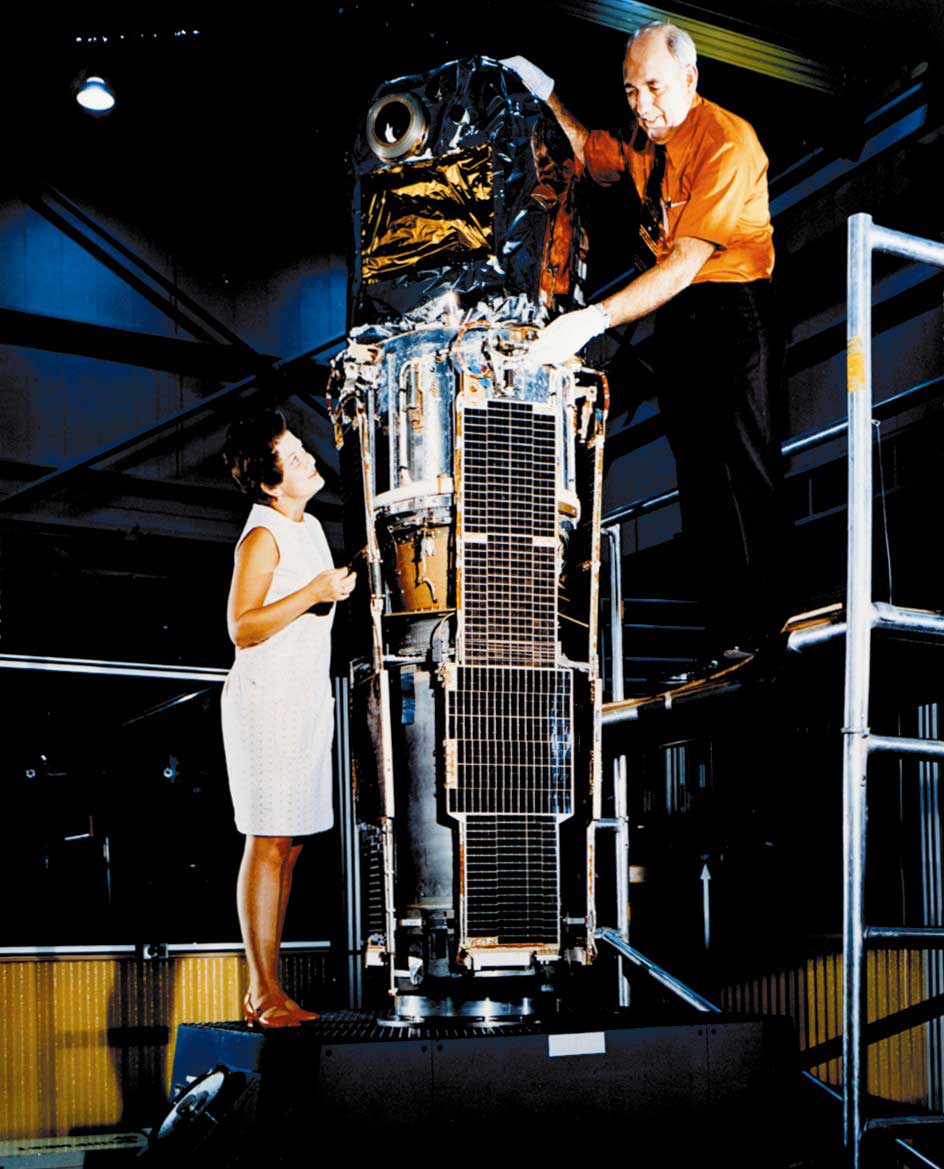X-ray and Gamma-ray Astronomy Observing Platforms
Earth's atmosphere absorbs most X-rays and gamma-rays. The more energetic X-rays (E > 30 keV) can penetrate the air for distances of at least a few meters (otherwise, Röntgen would never have observed them, and medical X-ray machines would not work). But, the Earth's atmosphere is thick enough that virtually none are able to penetrate from outer space all the way to the Earth's surface. X-rays in the 0.5 - 5 keV range, where most celestial sources give off the bulk of their energy, can be stopped by a few sheets of paper; ninety percent of the photons in a beam of 3 keV X-rays are absorbed by traveling through just 10 cm of air!
Therefore, to observe X-rays and gamma-rays from objects in space, we must put our telescopes and detectors above most of the Earth's atmosphere. The three ways scientists do this are with rocket flights, scientific balloons, and satellites.
Rocket flights

A sounding rocket launch. (Credit: NASA)
One of the earliest platforms for X-ray astronomy was sounding rockets. A detector is placed in the nose cone section of the rocket and launched above the atmosphere. The detector is above the atmosphere for 5 to 20 minutes, and then falls back to Earth.
The first sounding rocket for X-ray astronomy was launched from the White Sands Missile range in New Mexico in 1949. The V-2 rocket carried an experiment from the Navy that detected X-rays from the Sun. In 1962 the first X-rays from a source outside our solar system were detected by an experiment aboard an Aerobee 150 rocket.
The drawbacks of rocket flights are their short duration and limited field-of-view. While 5 to 20 minutes is not a long time, it is enough time for a detector to make a meaningful observation of a bright X-ray source. However, a rocket launched from the United States will not be able to see sources in the southern hemisphere sky, and a rocket launched from Australia will not be able to see sources in the northern hemisphere sky.
In the beginning of X-ray astronomy, sounding rockets were the best way to show that we can observe X-rays from celestial sources. Today sounding rockets are often used an an inexpensive way to develop and perfect new detector technology. While scientists may prefer to have an experiment on a satellite, which will last for years, they don't want to waste the money and time putting a detector on a satellite that won't perform well. By first testing a detector on a sounding rocket, astronomers ensure that only the best technology is developed for satellites.
Balloons

A scientific balloon preparing to launch. (Credit: NASA)
Balloon flights can carry instruments to altitudes of 35 kilometers above sea level, where they are above the bulk of the Earth's atmosphere. At this altitude, above 99.7 percent of the Earth's atmosphere, X-ray and gamma-ray photons with energies greater than 30 keV can reach the balloon's scientific payload. Unlike a rocket where data are collected during a brief few minutes, balloons are able to stay aloft for much longer.
Balloon-borne hard X-ray and gamma-ray imaging telescopes provided the first images of the sky in the energy range 20-1000 keV. They discovered black hole candidate sources in the galactic center region, first imaged the cobalt-decay gamma-rays from the spectacular supernova SN 1987A, and provided the first capability to localize (and thus study) high-energy sources for comparison with more detailed lower-energy X-ray observations.
In the past, balloon flights typically remained at float altitude from several hours to one or two days, at best. Nowadays, however, there are balloons called Long-Duration Balloons (or LDBs) which typically stay aloft for 3 weeks or more. They can carry a payload of over 2000 kg, allowing larger detectors with active experiment areas of up to 30 m2! Perhaps just as importantly in the modern era, balloon experiments are relatively inexpensive (when compared to satellite missions).
Satellites

Marjorie Townsend discusses the UHURU satellite's performance with Bruno Rossi during preflight tests at NASA's Goddard Space Flight Center. UHURU was the first satellite dedicated solely to studying cosmic X-ray sources. (Credit: NASA)
Satellites provide an excellent platform from which to observe cosmic X-ray and gamma-rays. A detector is placed on a satellite and then is launched into an orbit well above the Earth's atmosphere. Unlike balloons, instruments on satellites are able to observe the full range of the X-ray spectrum. Unlike rockets, they can collect data for as long as the instruments continue to operate.
Satellites are a great improvement for gamma-rays in particular, since the intensity, or flux, of cosmic gamma-rays arriving at the Earth is very low when compared to other sources of high-energy photons. Staying in orbit observing for many months or years allows scientists to gather more and more cosmic gamma-rays. And, the more gamma-rays scientists collect, the better their data analysis can be.
Text updated: September 2018


